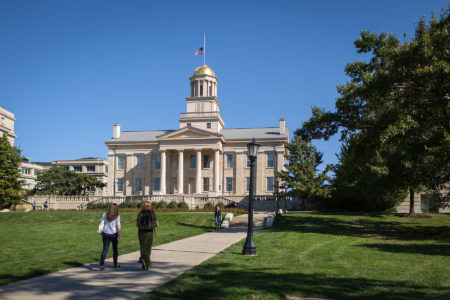On Monday, Feb. 20, University of Iowa President Bruce Harreld announced plans for the University of Iowa to increase renewable energy sources and be coal-free by 2025.
The University’s renewable energy program has been has been working toward a coal-free campus since 2003.
“It’s the right choice for our students and our campus, and it’s the surest path to an energy-secure future,” Harreld said in the press release about the initiative.
In addition to becoming coal-free by 2025, the University also set a goal of 40 percent renewable energy by 2020. The school began its initiative in 2003 with locally based biomass alternative fuels that were compatible with existing distribution and boilers. Since then, the school has planted 550 acres of Giant Miscanthus grass and has formed a partnership with Quaker Oats for collecting industrial by-products like oat hulls, according a the University of Iowa press release.
The University’s renewable energy initiative began when the University of Iowa Power Plant engineered an economical way of using oat hulls to co-fire with coal, and they can now use grass and wood chips, which they get from a pallet manufacturing facility.
The school’s goal is to plant 2,500 acres of Giant Miscanthus grass to supply a source for the school’s renewable energy initiative. Additionally, the perennial crops will improve erosion and water quality, a continuing issue in Iowa, and supply a wildlife habitat. This goal has been made in partnership with Eastern Iowa Airport and Iowa State University.
Grinnell College has not yet set a date to become carbon neutral, but a sustainability plan is expected. In 2011, President Raynard Kington signed the American College and University Presidents’ Climate Commitment, a climate change visibility effort by the organization Second Nature.
The American College and University Presidents’ Climate Commitment, or ACUPCC, has been joined by over 650 schools that commit to “measure and report their greenhouse gas emissions, take immediate actions to reduce them, and develop and implement a plan to go climate neutral,” according to an ACUPCC statement. While Drake University, Coe College and Grinnell College have all committed to the initiative, University of Iowa and Iowa State University have not.
The College has previously created carbon emission reduction goals and has been using environmentally responsible building criteria for all construction and renovation since 2006, according to the Grinnell College Environmental Stewardship.
Like University of Iowa, Grinnell College has been increasing sources of renewable energy, including “a 50 kilowatt wind turbine at CERA, a 21 kilowatt solar array on the Facilities Management office building, and a three kilowatt solar array on the Preschool,” said Chris Bair ‘96, the College’s Environmental and Safety Coordinator.
And while Grinnell still hasn’t made a carbon neutral initiative, Bair said that there are some plans in progress and, “hopefully that will change in the not too distant future.”

The University of Iowa announced its carbon free plan on Feb. 20.


















































